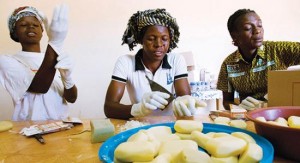Targeting African tastes emerges as latest sales drive
May 19— Major brands in the world’s consumer market can no longer expect easy acceptance in sub-Saharan Africa, as the region’s estimated one billion people use their purchasing power to buy products that suit their tastes.
Speaking in Nairobi recently, Brendan Grundlingh, Executive, Consumer Client Coverage at Standard Bank said the one-size-fits-all model should be thrown out the window, but new opportunities are opening up.
He said the larger multinationals that previously dominated the personal care sector are losing out to smaller local players. “Or are being forced to buy out and incorporate the offerings of local champions into their brands,” he said.
Some have been quicker than others to pick up Grundlingh’s message. In 2013, French giant, L’Oréal bought a majority stake in Interconsumer Products, the Kenyan health and beauty business founded by Paul Kinuthia nearly 30 years ago. L’Oréal made it no secret that Interconsumer’s popular Nice & Lovely brand was a big draw.
In Uganda, Movit and Samona products have built up a formidable market share by making cosmetics and associated items which are both affordable and suitable for a wide cross-section of Ugandan consumers.
Grundlingh said, “As such, looking ahead in Africa there is scope for smaller niche players- at home with ethnic and cultural diversity, for example – to win market share from larger multinational companies by using, the smart, the small, and the local, to scale products though innovation-or bring new technologies to delivery and service,” he said.
The Standard Bank’s Consumer sector team prides itself on the ability to unlock attractive African potential for businesses seeking new markets with a partner who can offer sound commercial navigation and balance-sheet backing.
Standard Bank South Africa is the largest operating entity of Standard Bank Group, Africa’s largest bank by assets. As of the end of December 2016, Standard Bank Group reported total assets of R1.95 trillion (about $143 billion) while its market capitalisation was R246 billion ($18 billion).
Grundlingh said key global consumer themes are now also evident and relevant in Africa. Combined with new technologies this presents Africans with a real opportunity to participate – as producers and suppliers of consumer products – in the world’s rapidly evolving and expanding consumer market.

Grundlingh says for too long Africa has been viewed as an exciting new market for a narrow range of global products.
“For too long Africa has been viewed as an exciting new market for a narrow range of globally produced and marketed consumer products. Today, however, the full range of global consumer themes –including health and wellness, convenience, indulgence, low/no calories and food protection – are now also major themes in Africa,” he said.
He said, “This not only presents global marketers with a wider market, but also, provides Africans with an opportunity to participate in the global consumer sector – as producers and suppliers – of new and innovative products that speak to global consumer trends.”
Grundlingh said as Africans adapt and combine technologies to service both local and global consumer opportunities, a world of new consumer product, service and support opportunities are emerging on the continent.
“There is huge opportunity, for example, for existing digital and new speech technology to utilise algorithms around discounting a basic basket of goods – targeting lower income households in Africa, for example. Innovation in e-commerce focused on digitally acquired consumer insights combining new distribution models, including, perhaps, delivery of goods or even medicines via drone to remote locations, is also presenting huge opportunity in Africa’s direct-to-consumer space,” he said.
He said there is no doubt that the global themes that have shaped consumer trends in the rest of the world are also present in Africa today. “What is different in Africa, however, is that these themes are evolving in a very different demographic, cultural, spatial and infrastructural environment, amongst populations that have proved much quicker at successfully adopting and adapting new mobile technologies,” Grundlingh said.
He said, “As a bank present in over 20 African economies, we are able to recognise – and support – the huge consumer opportunity that is currently unfolding across Africa.”
The most exciting aspect of this evolution is that beyond the continent’s rapidly evolving domestic consumer landscape, “Africa is, today, evidencing a strong ability to absorb consumer themes from the rest of the world, adapt these locally, and export new consumer combinations to the rest of the world. This is likely to make Africa an important global player in the world’s consumer landscape, not only as a recipient market – but also as a global originator, producer and exporter of consumer products and services,” Grundlingh said.


 African Heads of state head to South Korea next week for Summit talks
African Heads of state head to South Korea next week for Summit talks
 Trading leads as main source of income for Ugandans
Trading leads as main source of income for Ugandans
 New leadership for bankers’ umbrella as total assets top $12 billion
New leadership for bankers’ umbrella as total assets top $12 billion
 Brussels Airlines to announce Nairobi service
Brussels Airlines to announce Nairobi service
 SITA promises enhanced travel experience after Materna acquisition
SITA promises enhanced travel experience after Materna acquisition
 Saudia’s 105 aircraft order stretches A320neo lead over rival Max
Saudia’s 105 aircraft order stretches A320neo lead over rival Max
